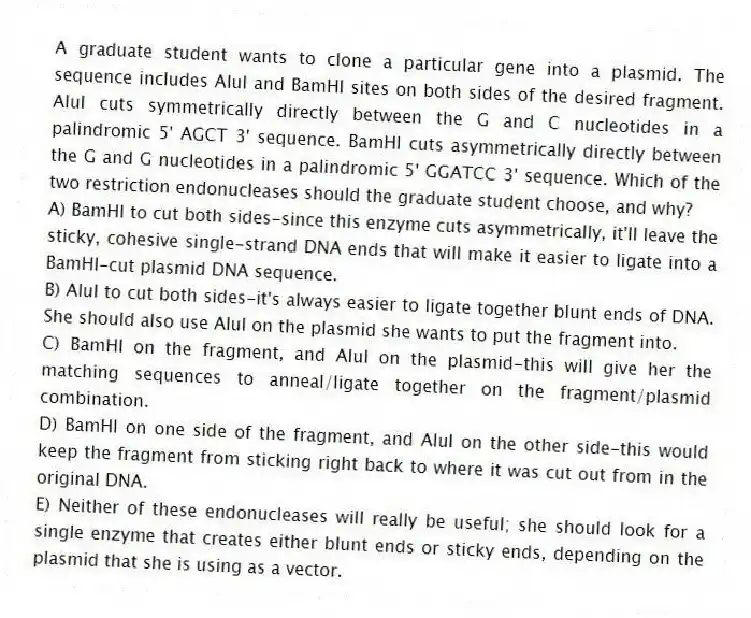
A graduate student wants to clone a particular gene into a plasmid. The sequence includes AluI and BamHI sites on both sides of the desired fragment. AluI cuts symmetrically directly between the G and C nucleotides in a palindromic 5' AGCT 3' sequence. BamHI cuts asymmetrically directly between the G and G nucleotides in a palindromic 5' GGATCC 3' sequence. Which of the two restriction endonucleases should the graduate student choose, and why?
A) BamHI to cut both sides-since this enzyme cuts asymmetrically, it'll leave the sticky, cohesive single-strand DNA ends that will make it easier to ligate into a BamHI-cut plasmid DNA sequence.
B) AluI to cut both sides-it's always easier to ligate together blunt ends of DNA. She should also use AluI on the plasmid she wants to put the fragment into.
C) BamHI on the fragment, and AluI on the plasmid-this will give her the matching sequences to anneal/ligate together on the fragment/plasmid combination.
D) BamHI on one side of the fragment, and AluI on the other side-this would keep the fragment from sticking right back to where it was cut out from in the original DNA.
E) Neither of these endonucleases will really be useful; she should look for a single enzyme that creates either blunt ends or sticky ends, depending on the plasmid that she is using as a vector.
Correct Answer:
Verified
Q53: When using lacZ containing vectors, colonies containing
Q54: Agarose gel electrophoresis may be considered as
Q55: DNA probes are used to find regions
Q56: In a FISH experiment, what would happen
Q57: Which of the following about DNA microarray technology
Q59: A very common vector is a plasmid.
Q60: You are examining the DNA profile of
Q61: The sequence of cDNA synthesized from an
Q62: If PCR is carried out on a
Q63: What would the outcome be if you
Unlock this Answer For Free Now!
View this answer and more for free by performing one of the following actions

Scan the QR code to install the App and get 2 free unlocks

Unlock quizzes for free by uploading documents